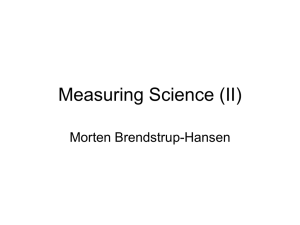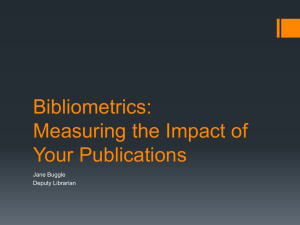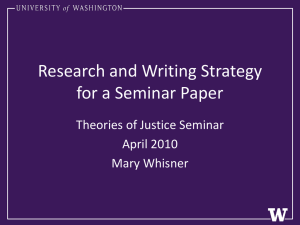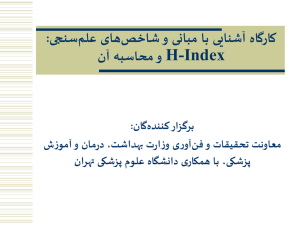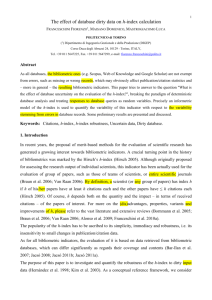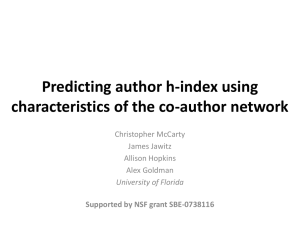New ways to track scholarly productivity: The g- and h
advertisement
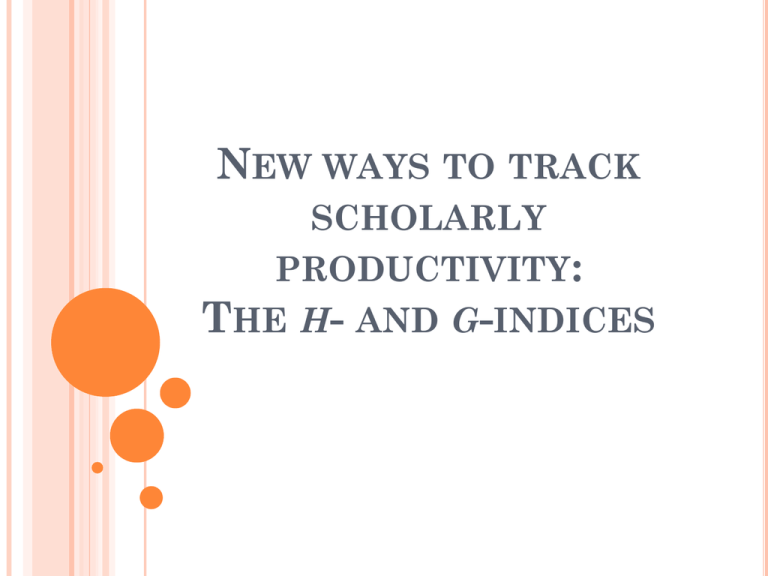
NEW WAYS TO TRACK SCHOLARLY PRODUCTIVITY: THE H- AND G-INDICES WHAT IS THE H-INDEX “A scientist has index h if h of his/her Np papers have at least h citations each, and the other (Np − h) papers have no more than h citations each.” [Hirsch, 2005] Shorter version: “an index of h has published h papers each of which has been cited by others at least h times.” WHO AND WHY Created by Jorge E. Hirsch, a physicist at UC-San Diego, to determine theoretical physicists' relative quality. The h-index grows as citations accumulate and thus it depends on the ‘academic age’ of a researcher. RANK=CITATIONS •Find all your papers. •Sort them by citation count. •Scroll down until the number of citations equals the number of the paper (in the example chart to your left, n=8). BENEFITS OF THE H-INDEX It is quantitative. It takes into account the QUANTITY of wellcited publications. The index is intended as a tool to evaluate researchers in the same stage of their careers. It is not meant as a tool for historical comparisons. Since the h-index increases with time, initial work that was published early is still relevant. Only the most highly cited articles contribute to the h-index. PROBLEMS WITH THE H-INDEX Self citations are in the list. Cross field comparison is difficult. As your h-index number increases, it becomes harder to increase it further. The lowest citation thresholds are in the Social Sciences, Computer Science, and Multidisciplinary Sciences. The h-index does not account for the number of authors of a paper. The h-index gives books the same count as articles making it difficult to compare scholars in fields that are more book-oriented. WHAT IS THE G-INDEX “Given a set of articles ranked in decreasing order of the number of citations that they received, the g-index is the (unique) largest number such that the top g articles received (together) at least g2 citations.” [Egghe, 2006] Shorter version: “this means that an author that produces n articles should have, on average, n citations for each of them, in order to have a g-index of n.” WHO AND WHY Created by Leo Egghe, Universiteit Hasselt, Antwerpen. g is expected to be a good correlation with the total number of citations an author has received, while h correlates with the highest number of citations which the most quoted paper brings to his author. Accordingly g is often greater than h. In 2010, the High Impact Universities Research Performance Index (RPI) was developed, analyzing research performance for 1,000 universities and 5,000 constituent faculties. RANKING CITATIONS •The g-index describes the consistency and quality of an institution faculty's research output. •Determine the g-index by ranking an individual’s publications in terms of the number of citations that each publication received. The top g publications should have received, in total, at least g^2 citations. BENEFITS OF THE G-INDEX It is quantitative. The g-index gives more weight to highly cited articles. The total number of documents does not limit the value of the index. The g-index might be more adequate than the h-index for assessing selective scientists **Researchers with selective publication strategies are those who do not publish a very high number of documents but who do attain a high impact PROBLEMS WITH THE G-INDEX Self citations are in the list. Cross field comparison is difficult. HOW DO YOU FIND YOUR H- AND G-INDEX? Web of Science Harzing’s Publish or Perish (uses Google Scholar) Google Scholar Caveats with each db Each database is likely to produce a different h for the same scholar, because of different coverage. Google Scholar has more citations but more chaff, however, the smaller citation collections are more accurate as to actual published works. SAMPLE: ANTOINE BERTINELLI Web of Science 65 papers 499 citations (no self-citations) Cites/paper= 7.15 Authors/paper: 1.80 h-index = 13 g-index = 18 Harzing Publish or Perish 68 papers [-3 lists/rosters = 65 papers total] 577 citations [includes self-citations] Cites/year: 11.78 Cites/paper = 8.88 Authors/paper: 1.80 h-index= 14 g-index = 22 BOTH ARE NECESSARY The existence of highly cited papers is heavily valued by the g-index. The h-index values a stable profile in the scientific performance of scientists but penalizes selective publication strategies. EXAMPLE: REAL PERSON: WOS Results found: 86 Sum of the Times Cited [?] : 610 Sum of Times Cited without self596 citations [?] : Citing Articles[?] : 590 Citing Articles without self-citations [?] 579 : Average Citations per Item [?] : 7.09 h-index [?] : 13 o Search on an individual’s name, mark all the citations reported in WOS, and then click on ‘Create citation report’. o Each report is accompanied by o Two charts, showing ‘published items in each year’ and ‘citations in each year’ o Searches only what is captured in WoS. o Does not include ephemera or ghost citations (Google does). EXAMPLE: REAL PERSON: HARZING’S PUBLISH OR PERISH Query date: 2013-01-28 h-index: 17 Papers: 63 g-index: 25 Citations: 776 e-index: 15.65 Years: 56 hc-index: 4 •Cites/year: 13.86 •hI-index: 8.50 •Cites/paper: 12.32/7.0/1 (mean/median/mode) •hI,norm: 12 •Cites/author: 501.66 •hm-index: 12.58 •Papers/author: 44.92 • Authors/paper: 1.76/1.0/1 (mean/median/mode) o Searches Google Scholar and returns results calculating the h- and g-indices for individuals and journals. o Provides links from the cited work to the citing works oCan be ported in Excel for further analysis EXAMPLE: REAL PERSON: GOOGLE SCHOLAR UNIVERSAL GADGET Citations for 'SAMPLE FACULTY' : 777 Cited Publications: 63 H-Index: 17 However, millions of Google Scholar (GS) records have erroneous metadata, as well as inflated publication and citation counts. GS lumps together the number of master records (created from actual publications), and the number of citation records (distinguished by the prefix: [citation]) when reporting the total hits for author name search. It is important to check and refine the data that the gadget performs calculations on by clicking on the “view publications” link and not take the returns at face value. HIRSCH (OF THE H INDEX) SAYS: Note Qualifier is for the field of Physics, “an h index of 20 after 20 years of scientific activity characterizes a successful scientist” “an h index of 40 after 20 years of scientific activity characterizes outstanding scientists likely to be found only at the top universities or major research laboratories” “an h index of 60 .. after 20 years …characterizes truly unique individuals” Hirsch JE. An index to quantify and individual’s scientific research output. PNAS 2005;102:16569-72.
